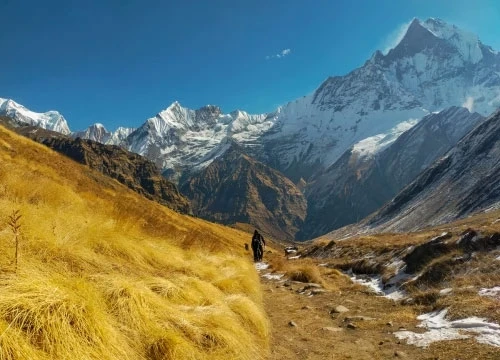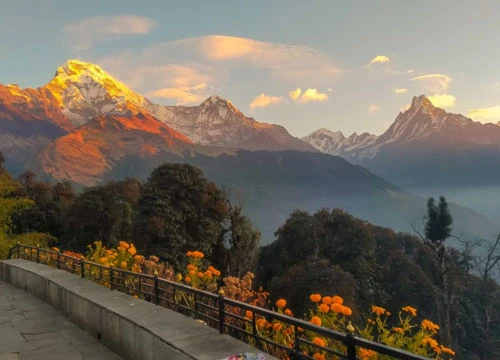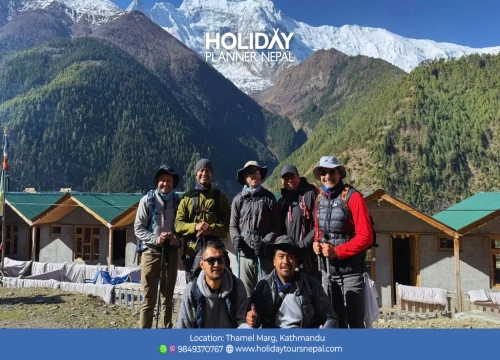Introduction: Royal Trekking in Nepal
The King Charles trekking trail is an easy and exquisite trekking destination in Nepal. This is so-called 'Royal Trekking” because it was the route used by Prince Charles of England in 1980, along with 90 people and luminaries like Mick Jagger (Rolling Stone Band). The Royal Trek is a short trek in Nepal’s middle hill in the awesome backdrop of lofty mountains like Annapurna (8,091m/ 26,545 ft), Machhapuchre (Fishtail) (6,993 m/ 22,942 ft), Dhaulagiri (8,167 m /26,795 ft), Manaslu (8,163 m/26,781 ft), and many others.
Royal Trek is a delightful trek that prepares trekking enthusiasts for the challenging treks to come. Compared to other trekking areas in the Annapurna Region. The Royal Trekking Route is less crowded, so visitors here can get closer to the nature, culture, and lifestyle of people in the location. One can savor a feeling higher than royalty by discovering oneself alive standing in front of the huge Himalayas. This trek is truly a boon to the trekkers.
The royal trek with views of the surrounding mountains offers the great ambiance of terraced rice fields and traditional Gurung village, while walking in the dense forests. The royal trek is not possible without entry into one of the protected regions of Nepal known as the Annapurna Conservation Area.
The Annapurna Conservation Area is home to various exotic and rare flora and fauna found in Nepal. the area is a habitat for 128 species of mammals, 518 species of birds, and 348 species of butterflies. Some of the animals and birds found here are the snow leopard, Kashmir musk deer, Himalayan musk deer, clouded leopard, red panda, Himalayan black bear, ghoral, Himalayan snowcock, black Francolin, common quail, mallard, Rufous-bellied woodpecker, common kingfisher, and many more.
The trail explored by King Charles is suitable to embark on all year-round in Nepal. However, the best seasons are spring and autumn, which last from March to May and September to November, respectively. Similarly, the trek is suitable for individuals who want to travel solo, in groups, or with families of children or elderlies.
The royal trek is a unique and exciting experience that captures the natural, cultural, and religious aspects of the Annapurna region. This is a once-in-a-lifetime trekking experience that allows trekkers to immerse themselves in the tapestry of nature.
How does the trail explored by King Charles start and end?
The Royal Trek starts from Kalikastan Ridge, about 25 km from scenic Pokhara, a beautiful lakeside city, and a 30-minute air flight from Kathmandu. The trek passes through beautiful Gurung hamlets. During the trek, we can enjoy stunning views of the eloquently built hillside rice terrace farmland, and as you hike the terraced farmlands, your eyes will behold the magnificent Annapurna I, II, III, IV, Machhapuchre (fishtail peak), Lamjung, Dhaulagiri, and other surrounding peaks that give you a view of nature’s beauty at its best.
On the whole trek, you will be followed by these mountain ranges, playing hide and seek. Annapurna Region Trek provides a great view of the Himalayas, located just nearby, north of the beautiful Pokhara valley, the scenery of panoramic mountains with green hills landscapes and typical hill land culture.
The trip finally ends at the scenic Begnas Lake, which is about 30 km west of Pokhara City, where we can have a relaxing time in front of beautiful lakes and huge Himalayas. You cannot imagine how wonderful this Pokhara valley looks with the light in the evening; that will steal your heart.
This short trek also offers you a great chance to experience the diversified culture of Nepalese western highland people with the typical houses, lifestyle, nature, and culture. The Royal Trekking can be taken as perfect due to the breathtaking view just with the easy trek routes.
Royal Trekking: Trail explored by King Charles III Altitude and Distance Coverage
Day | Activity | Altitude (m/ft) | Distance (km/miles) | Duration (hours) | Elevation Gain/Loss |
01 | Drive to Bijayapur, trek to Kalikasthan | 1,243 m / 4,078 ft | ~10 km / 6.2 miles (trek) | ~5 hrs (trek) | +1,243 m / +4,078 ft |
02 | Trek to Shaklung | 1,730 m / 5,675 ft | ~10 km / 6.2 miles (trek) | ~5-6 hrs (trek) | +487 m / +1,597 ft |
03 | Trek to Chisopani | 1,260 m / 4,133 ft | ~10 km / 6.2 miles (trek) | ~4-5 hrs (trek) | -470 m / -1,540 ft |
04 | Trek to Begnas Bazar and drive to Pokhara | 860 m / 2,822 ft | ~8 km / 5 miles (trek) + 20 km / 12.5 miles (drive) | ~3 hrs (trek) + 1 hr (drive) | -400 m / -1,312 ft (trek), -400 m / -1,312 ft (drive) |
What is the best time/season for heading to the King Charles trekking route?
The King Charles Trek can be done year-round in Nepal. However, the best trekking seasons or times is spring and autumn.
Spring, which lasts from March to May, is one of the best seasons for royal trekking. The temperature is moderate, which offers a comfortable walking experience. The skies are clear, with a vibrant atmosphere and an uninterrupted view of a mountain range in spring. Similarly, the day length is higher, which provides longer walking days. The alpine forests with rhododendrons come to full bloom, making the landscape livelier.
Likewise, autumn, which lasts from September to November, is another best season to embark on the royal trek. The skies are crystal clear, with an unobstructed view of a mountain range with stable and moderate temperatures. The landscape sparkles in a reddish-brown color as the leaves fall during the season.
Despite spring and autumn, the Royal Trekking Route can be conquered in winter and summer. Winter, which lasts from November to February, is off-season for trekking. This season is only recommended for expert trekkers or for those who wish to take on a challenge. The winter season is marked by extreme cold temperatures and snow, due to which the trails can be slippery and difficult to walk. Thus, careful preparation is required to travel in the winter.
On the other hand, the summer season, which lasts from May to August, is marked by heavy rainfall. The skies are full of clouds and foggy, which causes impaired visibility of mountain peaks. The trails are slippery, which causes difficulty in walking. Both summer and winter seasons require additional packing, so careful attention should be given to travel during these seasons.
Outline itinerary for Royal trek explored by King Charles III
- Day 01: Drive to Bijayapur and Trek to Kalikasthan (1,243m/ 4,078 ft), about 5 hours walk.
- Day 02: Trek to Shaklung (1,730 m/5,675 ft), a 5-6 hours walk.
- Day 03: Trek to Chisopani (1,260m/ 4,133 ft), 4-5 hours' walk.
- Day 04: Trek to Begnas Bazar and drive to Pokhara.



 General
General Upper Body
Upper Body Torso
Torso Lower Body
Lower Body Hands
Hands Feet
Feet Undergarments and Inner Wears
Undergarments and Inner Wears First Aid Kits and Medications
First Aid Kits and Medications Other Essentials
Other Essentials




